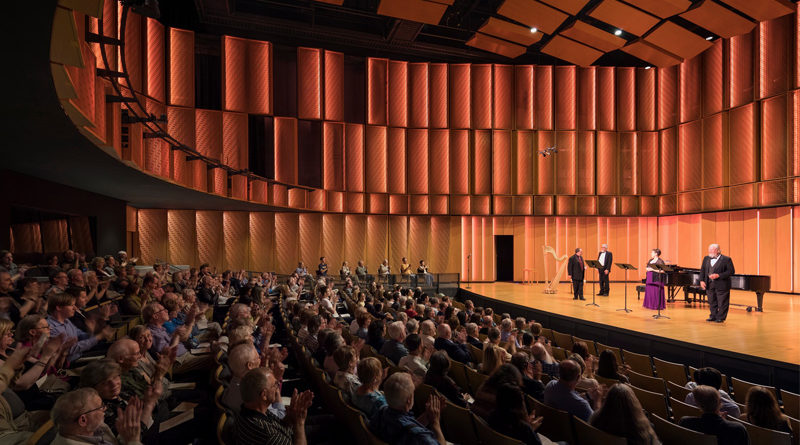HGA Designs Multidisciplinary Arts Complex for Carleton College
By Roxanne Squires
NORTHFIELD, Minn. – Carleton College’s music department is no longer divided between two buildings now that HGA Architects has delivered a brand new 55,000-square-foot multidisciplinary arts complex – dubbed the Weitz Center for Creativity.
Carleton College worked with the Minneapolis offices of HGA Architects and McGough Construction to design and build the new music and performance commons addition.
The $36 million complex was created to accommodate the majority of the music program while creating a new performance space of high acoustic quality to replace the existing Concert Hall.
“The design of the Music and Performance Commons addition consolidates and incorporates the disparate music department into this thriving center for the arts – breaking down barriers between music, theatre, and dance departments to create flexible academic program space utilized across multiple disciplines,” said Rebecca Krull Krailing, HGA senior project manager.
Music faculty offices, rehearsal spaces, the music resource library and teaching studios were also included in the project.
“Having to work within a limited site area and height restrictions, the design team craftily composed the three-level addition, taking into consideration acoustic isolation and shared program efficiencies,” said Krailing. “The addition seamlessly integrates into the existing complex with skillfully crafted brick detailing and massing that responds sensitively to the adjoining residential neighborhood.”
The centerpiece of the addition, a 400-seat Kracum Performance Hall, was designed to fulfill a variety of programmatic needs.
First and foremost, it had to function as an acoustically-excellent concert hall for the college’s ensembles, including choral, instrumental, jazz, percussion, non-Western music and acapella.
Additionally, the hall needed to accommodate dance performances, which require changes to lighting, stage configuration and acoustic treatment. Multiple easy-to-operate flexible acoustic and theatrical elements were incorporated into the design of the Performance Hall to allow it to quickly flex between these various types of performances.
Some of the features of the performance hall include: automated variable acoustic draperies concealed behind perforated wood screens; hinged upstage panels reveal absorptive and reflective surfaces; rotating side walls open to acoustic absorption in back of house; rotating side walls transform the stage configuration to accommodate dance performance; integrated, custom acoustic towers roll forward for an intimate acoustic backdrop; rotating ceiling panels above platform increase the acoustic volume; and integrated color-changing LED lighting within the acoustically transparent screens, which allow the room to transform in response to the performance.
Sound-isolated construction also allows the Kracum Performance Hall to be used simultaneously with adjacent rehearsal spaces, including two large ensemble rehearsal rooms, multiple faculty teaching studios and a chamber ensemble rehearsal room.
Additional back of house support includes dedicated storage, a recording studio that is wired to multiple spaces in the facility, a convenient and adjacent loading area and a green room suite.
Sustainable design strategies included advanced lighting strategies as well as an optimized chiller plant that allowed the project to achieve an Energy Use Intensity of 34 percent savings compared to the project’s baseline goal.
“The completed Weitz Center of Creativity follows the trend of a multidisciplinary approach to art facilities, but pushes that concept into reality by not only co-locating individual departments together within a single facility, but by incorporating unique spaces supported by technology for students and faculty to truly work across disciplines,” said Roxanne Nelson, AIA, LEED AP, HGA. “The Kracum Performance Hall is a prime example where collaboration is encouraged through its range of technical capabilities. The White Space, a highly flexible gallery, encourages students to curate and innovate across disciplines. Common spaces also foster and support the concept of flexibility around both social gatherings and informal performances.”
Design-wise, the facility also meshes with the surrounding context, occupying a tight site within a height-restricted residential neighborhood. Large windows reduce the visible mass of the structure and the red brick complements the materials used in the existing historic building, according to HGA.
Construction began in May 2016 and was completed in August 2017.

